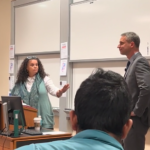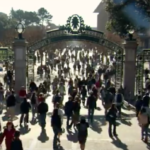What Made America Great?
![Crimson [250/366] by timsackton harvard crimson photo](https://www.academia.org/wp-content/uploads/2016/06/7968446722_9720dc8178_m_harvard-crimson.jpg) It is sign of the times that when people are told that Harvard was founded by a Puritan minister and dedicated to Christ and His Church, most react by wondering if this can actually be true. The reaction is evidence that Cultural Marxism has almost succeeded in eradicating the facts about the Christian roots of American education.
It is sign of the times that when people are told that Harvard was founded by a Puritan minister and dedicated to Christ and His Church, most react by wondering if this can actually be true. The reaction is evidence that Cultural Marxism has almost succeeded in eradicating the facts about the Christian roots of American education.
During her 2016 commencement address, however, Harvard President Drew Faust referred to gathering near Harvard’s Memorial Church, one of those “enduring symbols of Harvard’s larger identity and purposes, testaments to what universities do and believe at a time when we have never needed them more.” She added, “And much is at stake, for us and for the world.”
This was an extraordinary statement of historical accuracy. What’s more, she went on to tell the graduates that values should be a major influence in their daily lives.
She said, “For this morning’s ceremony I wore the traditional Harvard presidential robe—styled on the garment of a Puritan minister and reminding us of Harvard’s origins. Values were an integral part of the defining purpose of the early years of Harvard College, created to educate a learned ministry.”
It’s rarely mentioned these days, but the official website declares that “Memorial Church of Harvard University is a space of grace in the center of the Yard, rooted in the good news of Jesus Christ.” In fact, Harvard itself was rooted in that good news.
The real history of Harvard and other colleges is seldom mentioned in the new, modern, and secular America that we have today. But I went to my bookshelf for a copy of Vaughn Shatzer’s 1999 book, History of American Education, which tells the almost forgotten story of how Harvard and other colleges, including Princeton, Yale, William and Mary, Rutgers, and even Columbia, were based on a Christian worldview.
The facts in this small, 127-page book are not only important but politically relevant today, as Shatzer devotes a section to Hillary Rodham Clinton’s involvement in the federal takeover of America’s schools. That effort today is known as Common Core.
Going back in history, Shatzer writes, “Many of our Founding Fathers such as John Adams, John Hancock, Samuel Adams, and Fisher Ames attended Harvard. Amazingly, Fisher Ames, who proposed wording for the First Amendment, entered Harvard at age twelve.”
“Of the first 126 colleges formed in America,” he notes, “all but three were formed on Christian principles. Up until 1900 it was very rare to find a university president who was not an ordained clergyman.”
Is the pendulum now swinging away from Cultural Marxism and back toward America’s founding principles?
Referring to Widener Library and Memorial Church, Harvard President Faust said, “we need the qualities that both represent, because I believe that reason and knowledge must be inflected with values, and that those of us who are privileged to be part of this community of learning bear consequent responsibilities.”
She continued, “Up until the end of the 1800s, most American college presidents taught a course on moral philosophy to graduating students. But with the rise of the research university in the late nineteenth and the early twentieth century, moral and ethical purposes came to be seen as at odds with the scientific thinking transforming higher education.”
She added, “But in today’s world, I believe it is dangerous for universities not to fully acknowledge and embrace their responsibilities to values and to service as well as to reason and discovery. There is no value-free science. There is no algorithm that writes itself. The questions we choose to ask and the research we decide to support; the standards of integrity we expect of our colleagues and students; the community we build and the model we offer: All of this is central to who we are.”
The issue of “who we are” has to consider the Founding Fathers and who they were, and why America was so successful for so long.
Shatzer’s book looks at many of the Founding Fathers. However, one of them, Thomas Jefferson, is particularly fascinating because today he is regarded as having been a proponent of the “separation of church and state.” In fact, while president he was chairman of the school board of the District of Columbia. One of the principal textbooks was the Bible. Jefferson hired clergy to teach classes.
He founded the University of Virginia in 1817 and its official motto was a Bible verse, John 8:32, “And ye shall know the truth, and the truth shall make you free.” The scripture was also inscribed on the walls inside the Rotunda.
It may not be Harvard President Faust’s intention to return the American educational system back to its original Christian values. But in order to truly make America great again, the “values” she talks about have to be given their true meaning within the context of American society at large.
She concluded her address by saying, “Reason and responsibility. Widener and Memorial Church. Harvard and the world. We have a very special obligation in a very difficult time. May we and the students we send forth today embrace it.”
Her speech is a good first step, but can these brick and mortar colleges and universities be saved? Or have they been so corrupted that the real solution lies in an educational revolution that transfers learning to less expensive and mostly online institutions such as Amberton University, a nondenominational Christian institution? That university proclaims that its Christian commitment “does recognize its unique role in education and believes that the principles of Christianity and academic excellence run parallel, not perpendicular.”
Isn’t that what the Founders had in mind?
Cliff Kincaid is the Director of the AIM Center for Investigative Journalism, and can be contacted at cliff.kincaid@aim.org
Photo by timsackton 
Photo by timsackton 




